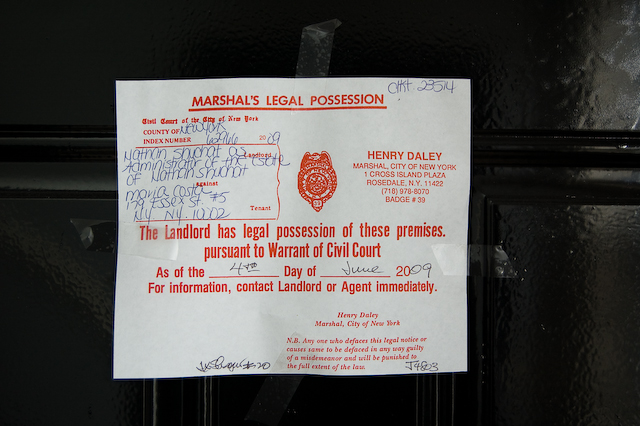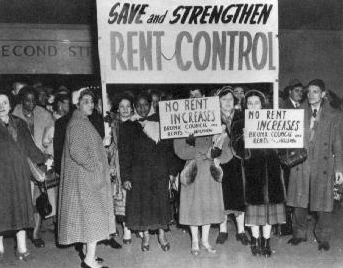
Is the House Still for Sale?
 As we enter the last days of summer, this author can’t help but notice that some houses for sale seem to have languished on the market for months unsold. This post will address the practical and legal ramifications of unsold houses. Because “For Sale” signs from real estate agents cannot be posted on cooperative or condominium apartments, requiring potential purchasers to search real estate listings online or in the newspaper, this post will address houses only.
As we enter the last days of summer, this author can’t help but notice that some houses for sale seem to have languished on the market for months unsold. This post will address the practical and legal ramifications of unsold houses. Because “For Sale” signs from real estate agents cannot be posted on cooperative or condominium apartments, requiring potential purchasers to search real estate listings online or in the newspaper, this post will address houses only.
In the suburbs surrounding New York City, most house sales occur with the school calendar in mind. For instance, a seller usually prepares her house to be listed starting in April, so that her buyer signs a contract by June, closes in August, and the buyer’s children can start school in the selected neighborhood in September. When the seller cannot follow this ideal schedule, she is limited to the buyers who are not concerned with the school calendar, which by its nature develops fewer potential buyers. If the property takes too long to sell, Thanksgiving and the holiday season arrive, along with winter weather, making buyers too busy or too uncomfortable to look at houses.
First, we should discuss when a seller is legally committed to sell a particular property to a buyer. In New York, until both parties have signed the contract and the downpayment has been deposited, the seller may enter a contract with any other buyer of his choosing. Our attorneys who are involved in real estate transactions are prepared to act quickly in response to an accepted offer on a property. When representing the seller, draft contracts are sent to the buyer’s attorney usually within a day. Likewise, when representing a buyer, we negotiate the contract and prepare it for signing in a similar timeframe.
Stock Transfers After Death
 It is not unusual for the estate of a deceased person to hold stock as an asset. Stock can take the form of shares held in a publically traded company, such as Target, or shares in a cooperative corporation. Clients often ask us how such shares can be transferred after a person passes away. This post will answer the question.
It is not unusual for the estate of a deceased person to hold stock as an asset. Stock can take the form of shares held in a publically traded company, such as Target, or shares in a cooperative corporation. Clients often ask us how such shares can be transferred after a person passes away. This post will answer the question.
First, it needs to be determined whether the person had a Will. If there was a Will, there may have been a specific bequest of the stock. This takes the form as follows: “I give all shares that I may hold at the time of my death in Target to my daughter.” If the stock is not addressed specifically, then the residuary clause of the Will manages its disposition. Anything not specifically addressed is left to the party receiving the residuary.
If the person did not have a Will, then the rules of intestacy would dictate who would receive the stock. In New York, Section 4-1.1 of the Estates Trust and Powers Law governs the situation. For instance, if the closest surviving person to the deceased is a child, then the child would inherit the stock under New York law.
Breaking Up is Hard to Do- The End of a Real Estate Transaction in New York
 Real estate transactions can “break up” prior to closing for a variety of reasons. The purchaser may receive a refund of his downpayment depending upon the circumstances. This post will address the legal issues associated with a deal breaking up.
Real estate transactions can “break up” prior to closing for a variety of reasons. The purchaser may receive a refund of his downpayment depending upon the circumstances. This post will address the legal issues associated with a deal breaking up.
Most contracts of sale contain a mortgage contingency clause. Such a provision provides that if the purchaser applies in good faith for the loan and supplies all information reasonably requested by the lender within the timeframe required by the contract, but is declined for the loan for any reason, the downpayment will be refunded to the purchaser. Readers should also be aware that the buyer may have a loan commitment, but the lender may not have cleared all closing conditions and ultimately may refuse to fund the loan. This situation may also give rise to the buyer’s right to the refund of the downpayment. In a contract without a mortgage contingency clause, the purchaser may be subject to the loss of his downpayment if he does not obtain the necessary funds to close. A qualified attorney should monitor her client, by entering the pertinent dates in a calendar and to request extensions of applicable deadlines should her client not have the loan commitment in the timeframe required by the contract.
Contracts pertaining to cooperative apartments typically contain a condition that the approval of the cooperative’s board of directors to the transaction must be obtained prior to closing. As in a standard mortgage contingency clause, the contract provides for the delivery of the board application package by a particular date, usually ten business days after the fully executed contract is delivered to the buyer’s attorney or ten days after the loan commitment is obtained. Should the board reject the purchaser, the downpayment must be refunded. However, if the buyer missed deadlines for the submission of the package or intentionally failed his appearance in the board interview, the downpayment may potentially be withheld.
Evictions and Warrants of Eviction in New York State
 Many of our clients are landlords who own only one property, such as a single or multi-family house or an apartment. Although they may be renting to a tenant, it is not their primary business or livelihood. As such, our firm is often asked to assist in removing a tenant due to a default under the lease, or due to the expiration of the lease in question. As discussed in a prior blog post, a Court proceeding is necessary in order to gain legal authority to evict a tenant.
Many of our clients are landlords who own only one property, such as a single or multi-family house or an apartment. Although they may be renting to a tenant, it is not their primary business or livelihood. As such, our firm is often asked to assist in removing a tenant due to a default under the lease, or due to the expiration of the lease in question. As discussed in a prior blog post, a Court proceeding is necessary in order to gain legal authority to evict a tenant.
The legal document allowing an eviction to occur is known as a warrant or warrant of eviction. It is similar to a judgment, except that instead of stating that a certain sum of money is owed, it states that the landlord has the legal right to evict a tenant. A warrant can be obtained in several ways during a Court proceeding. If the parties agree to settle a landlord-tenant action, the tenant may agree to vacate by a certain date. A condition of such agreement (known as a Stipulation or Stipulation of Settlement) would be that if the tenant does not vacate voluntarily, the landlord is entitled to a warrant of eviction. Often, the agreement will allow the warrant to be issued immediately, but the parties will agree to stay, or delay, enforcement of the warrant until after the date on which the tenant agreed to vacate the premises.
The Stipulation allows the landlord to have a warrant of eviction, but gives the tenant a reasonable amount of time (usually a month or two) in which to vacate. A crucial part of such an agreement is also that the tenant must pay use and occupancy during the period of time between settlement and moving out. Use and occupancy is a legal term which applies to rent paid after the tenant has agreed to surrender possession. The agreement will usually state that if the tenant fails to pay such use and occupancy, the warrant may be executed immediately upon notice of default sent to the tenant, rather than on the later date previously agreed to by the parties.
Rent Regulation in New York – The Newest Provisions
 A recent article in the New York Times describes a tentative deal in Albany to extend the rent regulation laws in New York. Rent regulation in New York exists not only in New York City, but also in other large cities, such as Yonkers and White Plains. To speak generally, rent regulations usually restrict the amount of rent that a landlord can charge for an apartment. In addition, tenants are usually legally entitled to a one or two year lease renewal, subject to certain restrictions. Landlords are permitted to raise the rent a certain percentage per year, subject to an overall threshold of rent.
A recent article in the New York Times describes a tentative deal in Albany to extend the rent regulation laws in New York. Rent regulation in New York exists not only in New York City, but also in other large cities, such as Yonkers and White Plains. To speak generally, rent regulations usually restrict the amount of rent that a landlord can charge for an apartment. In addition, tenants are usually legally entitled to a one or two year lease renewal, subject to certain restrictions. Landlords are permitted to raise the rent a certain percentage per year, subject to an overall threshold of rent.
The proposed deal in Albany would raise the rent at which an apartment can be “de-regulated” from $2,500.00 per month to $2,700.00 per month. What this means is that apartments which rent for more than $2,700.00 per month would no longer be subject to rent regulation, and landlords would be permitted to charge “market rate” for such apartments. In addition, tenants of a de-regulated apartment would lose their right to a renewal lease at a fixed rate of rent increase. For example, if one rented an apartment for $3,000.00 per month for a two year lease, at the end of the two year term, the landlord would be permitted to raise the rent to whatever amount the market could bear. If the tenant does not want to pay the new rent, they would have to vacate the premises.
Because rent stabilized apartments renting for below $2,500.00 (soon to be $2,700.00) a month are likely to be regulated, the landlord under such a system has an incentive to remove such tenants after their current lease expires. If the tenants vacate, the landlord is permitted a “vacancy increase bonus,” which allows them to increase the rent that a new tenant would pay, to an amount greater than the legally permitted increase for the current tenant’s renewal. For this reason, some landlords will make a cash offers to “buy out” tenants of their rent regulated tenancies. Our firm has handled these situations, representing both landlords and tenants in different transactions regarding such buyouts, and we have discussed the specifics of such buyouts in a prior blog post.
Adverse Possession: The Fundamental Elements have Changed in New York
 One of this author’s first lessons in Property Law class involved the concept of adverse possession. Under this legal principle, one party may acquire title to the property belonging to another. In New York, the elements required to establish adverse possession in the governing statute have been modified after 2008.
One of this author’s first lessons in Property Law class involved the concept of adverse possession. Under this legal principle, one party may acquire title to the property belonging to another. In New York, the elements required to establish adverse possession in the governing statute have been modified after 2008.
Prior to 2008, the following items had to be proven in order to establish the right to acquire title through adverse possession: hostile/adverse with claim of right/title (meaning that the possessor must believe that he owns the property); actual (an act on the part of the possessor must be conducted on the subject property); open/notorious (the possessor must be acting in a manner that an observant property owner would be able to see their activity); exclusive (if a fence, gate or wall is installed it may prevent other parties from entry and make the possession exclusive to the possessor); continuous for ten years (the owner is out-of-possession for at least ten years); and likely to be cultivated or improved (gardening, lawn mowing and the like have been conducted by the possessor or the possessor built a structure such as a shed or other building) or protected by an enclosure (such as a gate or fence). Permissive use does not give rise to an adverse possession claim.
As a result of the New York recent case known as Walling v. Pryzyble , the “hostile” element from the adverse possession standards has been removed. Further, property need not be cultivated or improved to give rise to an adverse possession claim. The updated standard is that there is a reasonable belief that the property belongs to the possessor.
Foreclosure and Bankruptcy in New York
 A recent decision by the United States Supreme Court raises important issues for those whose homes are in foreclosure and are considering filing for federal bankruptcy protection. This case involved a borrower whose home was “underwater,” which means that the mortgage debt on the property (both a first and second mortgage) exceeded the current value of the home. In such cases, the bankruptcy counsel will often seek to have the second mortgage “stripped off,” that is, removed, so that it is no longer a lien on the property.
A recent decision by the United States Supreme Court raises important issues for those whose homes are in foreclosure and are considering filing for federal bankruptcy protection. This case involved a borrower whose home was “underwater,” which means that the mortgage debt on the property (both a first and second mortgage) exceeded the current value of the home. In such cases, the bankruptcy counsel will often seek to have the second mortgage “stripped off,” that is, removed, so that it is no longer a lien on the property.
The Supreme Court ruled that, in such situations, the second mortgage could not be removed simply because the house was worth less that the total mortgage debt. This ruling will prevent such homeowners from having second mortgage loans (which are often in the form of home equity loans) discharged by the Bankruptcy Court in a Chapter 7 liquidation proceeding. This ruling protects banks that make second mortgages from having these mortgages dismissed in bankruptcy proceedings where the home currently has a negative equity.
Our firm handles many cases in which we defend homeowners who are in foreclosure. We are often asked what the effect of a bankruptcy filing would be on such a proceeding. The first effect of a bankruptcy filing is to freeze all current litigation against the person filing for bankruptcy, as well as all collection efforts on any debts. Therefore, if an individual is delinquent in their mortgage payments, a bankruptcy filing would suspend all collection letters, phone calls, and, of course, litigation relating to all debts, including mortgage debts. Failure to comply with the automatic bankruptcy stay may subject the lending institution to Court sanctions, including fines.
Where Will You Be Driving This Memorial Day Weekend?
 After another harsh winter in New York, many of us are looking forward to getting away this Memorial Day weekend. Those of us who are driving may have acquired the vehicle from an estate. This post will address estate issues as they pertain to cars and other vehicles.
After another harsh winter in New York, many of us are looking forward to getting away this Memorial Day weekend. Those of us who are driving may have acquired the vehicle from an estate. This post will address estate issues as they pertain to cars and other vehicles.
As many of us know, cars in New York involve title, registration, and insurance. They may also involve a lease or a loan. We have written another post concerning how to manage debts of the deceased. The first step is that the Surrogate’s Court of the County in which the deceased resided needs to appoint an executor (if there was a will) or an administrator (if there was not a will). The executor or administrator needs to act on behalf of the estate to manage all relevant aspects of this matter.
Every car must be insured. The executor or administrator should employ his best efforts to maintain the insurance policy on the vehicle. Certainly, the car should not be driven if insurance has lapsed, because this could result in a ticket from the police if one happens to be stopped for another violation.




